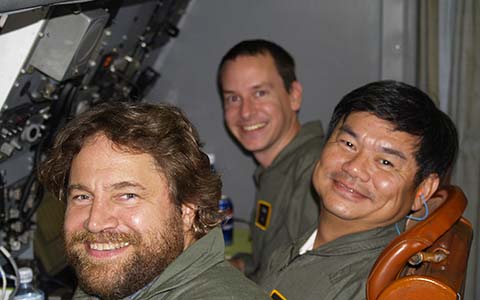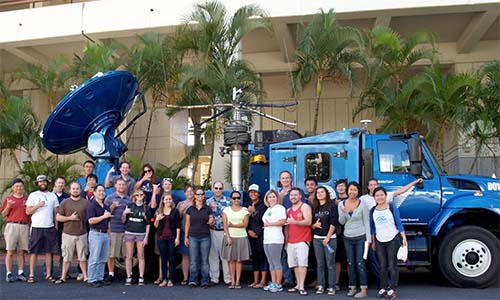Opening doors to a career in geoscience
Award-winning scientist recalls mentoring that made a difference
Mar 8, 2017 - by Staff
Mar 8, 2017 - by Staff
March 8, 2017 | Michael Bell, recently honored as one of America's outstanding early-career scientists, took an unconventional path to becoming a top tropical cyclone researcher.
Bell said he always had an interest in meteorology but the University of Florida, where he first attended, didn't have that major. "I started as a physics major, but I realized that high energy particle physics wasn't for me." So, because he had enjoyed his comparative religion classes, he wound up as a religion major.
But since he already had taken many math and physics courses, it was relatively straightforward to go back to school and pursue a second bachelor's in mathematics and meteorology at Metropolitan State College (now Metropolitan State University) in Denver. There he had a professor, Anthony Rockwood, who had worked at the National Center for Atmospheric Research and encouraged Bell to apply for a student assistantship.
 Michael Montgomery, Michael Bell, and Wen-Chau Lee (left to right) during the THORPEX Pacific Asian Regional Campaign in Guam in 2008. Lee was Bell's mentor at NCAR and Montgomery, of the Naval Postgraduate School, was Bell's Ph.D. adviser. (Photo courtesy Wen-Chau Lee, NCAR.)
Michael Montgomery, Michael Bell, and Wen-Chau Lee (left to right) during the THORPEX Pacific Asian Regional Campaign in Guam in 2008. Lee was Bell's mentor at NCAR and Montgomery, of the Naval Postgraduate School, was Bell's Ph.D. adviser. (Photo courtesy Wen-Chau Lee, NCAR.)
The cliché is that the rest is history, and it fits in this case. Bell was so successful as a student assistant that he would spend another decade at NCAR before leaving for academia. In December 2016, President Obama honored Bell as one of America's outstanding early-career scientists. The Office of Naval Research nominated Bell for the award in recognition of his hurricane and typhoon research, much of which was done for the Navy.
"This is a career highlight for me, " Bell, wrote in an email to his mentor Wen-Chau Lee, an NCAR senior scientist, shortly after being notified of the honor. "I owe you a debt of gratitude for all of the opportunities you have provided me over the years."
"NCAR taught me to think critically about data quality and the assumptions that go into data," Bell, now an associate professor at Colorado State University, said in a recent interview. "The field projects (which included flying close to hurricanes) taught me the importance of careful planning and execution, so when the weather you want to study occurs, you're ready to take advantage of it."
Bell's enthusiasm and desire to learn impressed the NCAR hiring team, Lee recalled. "He said, 'I want this, I think I can do it.'"
"I have to invest a lot of time to train a student assistant," Lee said, "so I wasn't looking for a candidate with a ton of programming experiences who would stay a year and leave. I was looking for someone who could assist me over the relatively long term, and I had a feeling that Michael could do it."
During his stint at NCAR, Bell was part of at least a half-dozen field campaigns, including RAINEX (Hurricane Rainband and Intensity Change Experiment) in 2005, and T-PARC (THORPEX Pacific Asian Regional Campaign) in 2008. He served as a principal investigator for PREDICT (Pre-Depression Investigation of Cloud Systems in the Tropics), which examined hurricane formation.
Lee, Bell, and Paul Harasti of the Naval Research Laboratory also co-developed a tool called VORTRAC (Vortex Objective Radar Tracking and Circulation) that enabled hurricane specialists for the first time to continually monitor central pressure as a fast-changing storm nears land.
The National Center for Atmospheric Research and the University Corporation for Atmospheric Research have a tradition of helping develop the next generation of scientists.
In fiscal 2016 alone, there were more than 400 examples of NCAR and UCAR scientists and engineers working with student-scientists on activities such as mentoring, advising, thesis review, and teaching.
"There's no shortage of channels available to get great students from prestigious organizations, but the kind of informal programs like student assistantships show how NCAR opens the door for people who otherwise wouldn't get the opportunity," said Senior Scientist Wen-Chau Lee of NCAR's Earth Observing Laboratory.
There are also several formal examples, including SOARS (Significant Opportunities in Atmospheric Research & Science), a UCAR program begun more than two decades ago to broaden participation in atmospheric sciences. In fiscal year 2016, about 65 student protégés either participated in SOARS internships or were supported through webinars and career advising.
With mentoring opportunities from undergraduate internships through postdoctoral fellowships, NCAR|UCAR student-scientists have gone on to successful careers in government labs, academia, and the private sector, and many have taken on leadership roles. In the SOARS program alone, more than 100 students have earned a master's degree in science or engineering to date, and three dozen have gone on to get their Ph.D.s.
While working at NCAR, Bell earned a master's degree in atmospheric science from Colorado State University and a Ph.D. in meteorology from the Naval Postgraduate School. The Education Assistance program of the University Corporation for Atmospheric Research paid tuition for his master's degree. (UCAR manages NCAR with sponsorship by the National Science Foundation.)
"Michael always took advantage of the opportunities provided to him," Lee said. "There's an old saying of Confucius that to be a mentor or teacher is like being a big bell. The harder a student hits the bell, the greater the sound. If a student is eager to learn, I will put forward more from my end to challenge them."
 Graduate students at the University of Hawaii received radar training from Wen-Chau Lee (NCAR, far left) and Michael Bell (University of Hawaii, back row, second from left) in 2013 during an educational deployment of a Doppler on Wheels radar system that was sponsored by the National Science Foundation. Lee's participation was supported by the UCAR UVisit program. (Photo courtesy Wen-Chau Lee, NCAR.)
Graduate students at the University of Hawaii received radar training from Wen-Chau Lee (NCAR, far left) and Michael Bell (University of Hawaii, back row, second from left) in 2013 during an educational deployment of a Doppler on Wheels radar system that was sponsored by the National Science Foundation. Lee's participation was supported by the UCAR UVisit program. (Photo courtesy Wen-Chau Lee, NCAR.)
Recalling Bell's early years, NCAR scientist Bob Rilling said: "Michael had a real curiosity and an analytical approach to problems. You could see his wheels turning. He wanted to make things work."
The relationship between NCAR and Bell continued long after he moved on in his career.
For example, in 2013, Bell invited Lee to the University of Hawaii as part of a UVisit program administered by UCAR. Lee gave lectures to Bell's radar class and helped Bell train graduate students during a Doppler on Wheels educational deployment as part of the Hawaiian Educational Radar Opportunity, a program sponsored by the National Science Foundation.
Lee in turn asked Bell to become the principal investigator on a new project called the Lidar Radar Open Software Environment, or LROSE.
LROSE aims to develop a unified open source software tool to handle the copious quantities of atmospheric data produced by radars and lidars. The collaboration won a competitive grant from the National Science Foundation Software Infrastructure for Sustained Innovation program, and a community workshop is planned for April at NCAR.
Summing up NCAR's role in his professional life, Bell said, "I worked with a lot of good people, like Wen-Chau, and they really helped launch me into my current career."
Writer/Contact
Jeff Smith, Science Writer and Public Information Officer